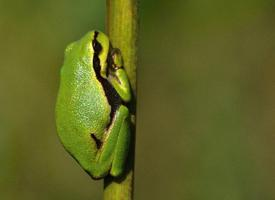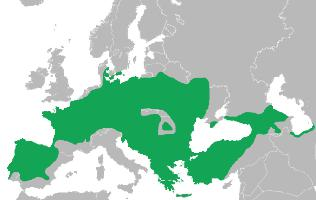
Poids et mesures
| Hauteur au garrot | de 3 à 4 cm |
|---|---|
| Longueur | de 3 à 5 cm |
Statut de conservation
| Menacé |
Description de l'animal
The European tree frog, scientifically known as Hyla arborea, is a small, enchanting amphibian species that resides in various parts of Europe and parts of Asia and North Africa. This species is particularly noted for its vibrant green coloration, which serves as an effective camouflage amidst the foliage where it spends a significant amount of its time. The European tree frog is a member of the Hylidae family, which is characterized by its members' exceptional climbing abilities and affinity for arboreal habitats.Adult European tree frogs are relatively small, typically reaching lengths of about 3 to 4.5 centimeters. They have slender bodies, long legs, and large toe pads that are well-adapted for gripping onto branches and leaves. Their skin has a smooth texture and can vary in color from a bright, leafy green to a more subdued brown or gray, depending on the frog's surroundings and the temperature. This ability to change color helps them to blend into their environment, making them less visible to predators.
One of the most distinctive features of the European tree frog is its large, forward-facing eyes that have horizontal pupils. These eyes are not only striking in appearance but also provide the frog with excellent night vision, which is crucial for spotting prey and avoiding predators in the dim light of dusk and dawn.
The European tree frog's diet primarily consists of a variety of insects and other small invertebrates. It is a nocturnal hunter, using its keen vision and quick reflexes to catch prey. During the day, it usually rests in concealed locations among the foliage, only emerging at night to feed.
Breeding season for the European tree frog typically occurs in the spring, following their emergence from hibernation. They are known for their loud and melodious mating calls, which males produce from water bodies to attract females. These calls are a familiar sound in their habitats during the breeding season. Females lay their eggs in stagnant or slow-moving waters, where the tadpoles will develop. The tadpoles undergo metamorphosis into froglets during the summer, eventually leaving the water to join the adult population in the trees.
The European tree frog inhabits a variety of environments, including forests, meadows, gardens, and agricultural areas, as long as suitable wetlands or water bodies for breeding are nearby. Despite its adaptability, the species faces threats from habitat loss, pollution, and climate change, which have led to declines in some populations.
Conservation efforts are underway in several countries to protect the European tree frog and its habitat. These efforts include creating and preserving wetlands, reducing pesticide use, and implementing legal protections. The European tree frog plays a vital role in its ecosystem, serving as both predator and prey, and its presence indicates a healthy, biodiverse environment.
In summary, the European tree frog (Hyla arborea) is a small, arboreal amphibian known for its striking green coloration, nocturnal habits, and melodious mating calls. It inhabits a range of environments across Europe and parts of Asia and North Africa, where it plays an important role in local ecosystems. Despite facing several threats, efforts are being made to ensure the survival of this captivating species.
Carte de répartition

Nouvelles photos d'animaux
Top 10 des animaux
- Dolphin gull (Leucophaeus scoresbii)
- Japanese macaque (Macaca fuscata)
- Stone loach (Barbatula barbatula)
- Greek tortoise (Testudo graeca)
- Russian tortoise (Testudo horsfieldii)
- Galápagos tortoise (Geochelone nigra complex)
- Diana monkey (Cercopithecus diana)
- Moustached guenon (Cercopithecus cephus)
- Common flying dragon (Draco volans)
- Galápagos penguin (Spheniscus mendiculus)